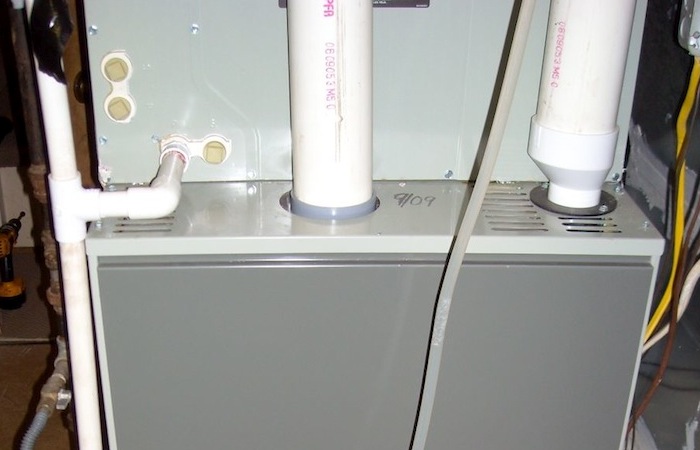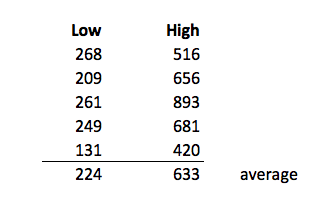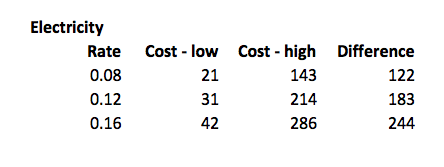When Is a High-Efficiency Furnace Not?

You can tell how energy efficient a furnace is by its official efficiency rating, the Annual Fuel Utilization Efficiency (AFUE). It’s a measure of how much of the heat originally in the fuel that’s being burned is available for delivery to the home. The more heat that gets lost up the flue or through the cabinet, the lower the AFUE. But that rating doesn’t capture all the ways a furnace can lose efficiency. Some, like how well the heat gets delivered to the house, aren’t related to the furnace itself. But there’s one big one that is related to the furnace.
Unlike air conditioners and heat pumps, furnaces use two sources of energy. The fuel that it burns is the obvious one. (It’s usually natural gas or propane.) The other is the electricity that runs the blower. And that’s the key to finding a high efficiency furnace that truly operates at high efficiency.
A peek at manufacturer’s specs
I was working on a mechanical design for one of our clients recently and was going through the equipment selection process. The software we use (RightSuite Universal) has a lot of equipment data built in, so I can just find a manufacturer, set the limits for sizing and efficiency, and look at the options.
Once I get my list of options reduced to a reasonable number, I can choose a model that meets my requirements. But I have to go in and make sure to look at the blower power rating for each one or I could end up saddling the client with a furnace that looks like it should be efficient but isn’t really.
I took a look at the RightSuite listed blower power ratings for five different manufacturers. The furnace capacities were all in the range of 40-44 thousand BTU per hour (kBTU/hr) with AFUE ratings of 94.1 to 96.5. The table below shows what I found for how much electric power they would use. I looked at several models for each manufacturer and am showing here the lowest and highest power rating for each one.

That’s quite a difference. The average high blower power (633 W) is nearly three times the average low blower power (224 W). And the worst one in there (893 W) is another 41% higher than the average high.
The effect of an energy hog blower
What this means is that when you choose a furnace, the effect on the heating bill hits two ways. A higher AFUE means you pay a lower gas bill. It does not mean, however, that your overall energy bills are lower. If you live somewhere with a mild climate, it may not affect you very much. The more that blower runs, though, the higher the electricity bill will be.
Also, remember, when you pair a furnace with an air conditioner or a heat pump, that same blower is used for heating and cooling. So if the furnace blower is an energy hog, the homeowner will pay for it year-round.
Let’s look at some numbers. To figure out how the blower’s power use affects your electricity bills, we need to know how many hours it’s going to run. If you look online for annual runtime, you’ll see some numbers that are too high. One I found was as high as 3,600 hours per year, implying that the system runs an average of 10 hours per day, 365 days per year. If that’s really the case, I’ve been wasting my time talking about oversized air conditioning systems.
So I checked with someone who knows and found out that the national average is probably around 1,500 hours per year. In hot climates, where the air conditioner runs a lot, it’s more like 2,000 hours per year. But those numbers include a lot of oversized systems that short-cycle. Right-sized systems run more. Since we design systems that aren’t nearly as oversized as the typical ones, I’ll use 2,000 hours in my calculations.
The most efficient blower in the table above burns 131 W. Multiply that by 2,000 hours, convert from W to kW (divide by 1,000), and we find that this blower uses 262 kWh per year. The worst blower burns 893 W, so its annual consumption is 1,786 kWh. Wow! That’s almost six times more electricity use.
Of course, the other big factor that affects the electricity cost is the rate you pay, so I calculated the annual cost for these two blowers for three rates, $0.08, $0.12, and $0.16 per kilowatt-hour (kWh).

As you can see in the table above, the difference between low-power blower and a high-power blower can be significant. If the furnace lasts 15 years, it can cost $2,000 to $3,000 extra if you make the wrong choice.
Bottom line: Check your specs!
What I’ve presented here is a simplified analysis. To get to the actual effect of the blower on your energy bills, we’d need to know about the ducts. A well designed and installed duct system won’t resist the air flow as much as a typical duct system, and that affects the blower. Another real-world factor is that actual performance usually differs from manufacturer’s specifications. When you can get actual data, you can make an even better decision.
Still, using the manufacturer’s specs is a good first step. Not all high-efficiency furnaces are created equal, and when looking for a furnace you should be aware that the AFUE is only one part of the efficiency. Be sure to look at the blower power, too, because that can have a huge effect on your energy costs. And if your utility is selling you dirty electricity, you pollute more as well.
Related Articles
Does a Gas Furnace Dry Out the Air in Your Home?
How NOT to Retrofit a Furnace in a Spray Foam Insulated Attic
How Can Replacing a Furnace Make You Less Comfortable?
NOTE: Comments are moderated. Your comment will not appear below until approved.
This Post Has 11 Comments
Comments are closed.

The best way to analyze or
The best way to analyze or compare blower energy among competing furnace models is to refer to the blower table cross-referenced to the estimated total static pressure at heating speed and cooling speed (some mfrs publish watts on the blower table, some don’t).
In general, a furnace with an ECM blower will use significantly less electricity than an otherwise equivalent furnace with a PSC motor. The lower the external static, the bigger the difference, but an ECM will always be more efficient at a given airflow and static.
There are 2 motors in a HE
There are 2 motors in a HE furnace is there not? And how about standby power? In the world of power adapters, they have to meet a limit of 0.1W max standby power, but for HVAC equipment I hardly ever see standby discussed.
Excellent point David.
Excellent point David.
These are good baby steps in the initial learning curve about system selection. One of the problems though is that manufacturers lie and make up stuff.
The game changer is when technicians gather and analyze actual system performance data from their installations ad discover what systems actually perform best. And when they find they can’t deliver as much efficiency into the home as they want (like aiming for an A in distribution system efficiency and getting a C), things are learned like the furnace penalty of higher temperature air and resulting larger Btuh losses within the distribution system than lower delta systems (Heat pumps, low flow hydronics for example), or the penalty of lower CFM airflow and corresponding lower fan Watts (higher distribution losses due to longer transit time to destination).
Good designers comb literature and modeling programs. Great ones measure and base their decisions on actual equipment performance.
At the risk of broadcasting
At the risk of broadcasting my ignorance, which frankly, has never stopped me in the past, can someone provide a short answer to why the important aspects of overall furnace efficiency Allison raises are not an elemental part of furnace certification?
The furnace manufacturer says
The furnace manufacturer says my furnace will deliver the advertised efficiency when you, the designer/installer, provide it with a proper distribution system. The furnace has a rating plate that clearly states the maximum external static pressure the furnace or air handler can work against and still deliver the goods. Once you exceed the parameter, which is 0.5″ w.c. total external static pressure, then bad things start happening. It’s like a car manufacturer says his car works properly on quality paved roads. Take it off road or haul heavy loads beyond its rated capacity, then, once again, bad things start happening. Heating contractors have to make sure the road (duct system) is as good as it can be.
Well heck. I know for a
Well heck. I know for a variable speed blower, it can be the most efficient. But its power depends on the static pressure it must work against… the duct system and chosen airflow is a key factor. What static pressure did you use for your model?
Thank you.
@Terje, I believe you’re
@Terje, I believe you’re referring to the inducer motor. That’s really small potatoes compared to the blower. But standby power is definitely an issue for unitary equipment. That, plus crankcase heaters for heat pumps can easily add hundreds of kWh’s annually to overall consumption. Unfortunately there’s no good way to incorporate these loads into a model other than by empirical measurement, as Mike is advocating.
@Mike, all good points. I’ve definitely seen bogus data in the tables based on field measurement. But excepting outright errors, I find that blower watts is usually within 10 or 15 percent. And as I’m sure you know, and to Treje’s point, it’s important to understand that blower table (watts) doesn’t purport to include power consumed by thermostats, transformers, relays or solenoids (or the inducer fan).
In any case, as a 3rd party designer and specifier, I’m often limited by what the contractor sells, in which case I may not have the luxury of empirical data. My point was simply that manufacturer blower tables are much better than the (ARHI) electrical consumption data included in RightSuite.
I appreciate David’s point
I appreciate David’s point about ECM efficiency AT A GIVEN CFM AND TESP. This is what HVAC balance points are all about. Many homeowners may be shocked to see their cost of fan operation (and thus electricity bills) go up when they replace their tired-out PSC. The HVAC contractor didn’t make any bogus claims- they just forgot to test/optimize the watt-draw.
@Mark, non-variable ECM has
@Mark, non-variable ECM has the same efficiency as variable speed (the motor itself may indeed be identical), but at a much lower cost. Some VS blowers eek out a few percentage points improvement through operational profiles (e.g., stepped ramp-up) but these differences are small and are not captured in either the official ratings or blower tables. Your point about static is spot on. In fact, many contractors (ab)use variable speed blowers (specifically models with constant CFM feature) to ensure correct airflow, but then they build a crappy duct system that pushes the blower to the top of its power curve. Sigh.
To Blake’s point, it’s important to look at motor efficiency as opposed to motor watts. For example, if you replace a PSC that’s operating at 60% of design airflow with an ECM, a good contractor will take the opportunity to fix the airflow, so blower watts may still go up. If the duct system is undersized or a leaky duct system is sealed without enlarging it, an ECM may get pushed further up its power curve than you’d like. But on a CFM-per-watt basis, it’s still more efficient than a PSC.
Steve asks why furnace ratings don’t appropriately reflect blower energy… Blower energy has always been the unwanted stepchild of equipment rating procedures. For example, SEER and HSPF ratings for air conditioners are not necessarily based on tests with the matched blower. Most ratings are modeled (simulated) from baseline tests. in that case, the blower energy component (for SEER & HSPF ratings) only varies depending on whether the blower is PSC or ECM. Also, baseline tests upon which these simulated ratings are based do not have to be conducted at a particular airflow (although the tested airflow must now be disclosed on the ratings).
This situation evolved from a time when blower energy was much less consequential to system energy consumption. Clearly that’s no longer true, as source equipment efficiency improvements have far outpaced blower efficiency. AHRI rating procedures are specified by the DOE and thus are subject to public comment. There’s naturally going to be resistance (from manufacturers) to any change that would require more actual testing and/or make their products look worse.
Dear Alison,
Dear Alison,
I was reading your article title “How to tell if you have an oversized unit”. I think i may have an oversized unit. I doesn’t run more than 6 minutes. But on a warm day like today’s it runs after ever 20 minutes or so. But my main problem is humidity. Here are some of the stats i took today. If you can please look over the stats and let me know if something stands out as obvious or possible culprit for the humidity issue in my home:
Outside Temp 80F with 62% humidity (although i am running a 70 pint dehumidifier in the living room which pumps out hot air – away from the bedroom where the reading is taken. Therefore its more like emulating 95+ outside temp. My house is 1850 square foot single storie, with a 4 ton unit), AC set to hold at 77F
All data recorded via off the shelf thermometer from home depot. readings taken while sitting the thermometer on the Bed’s footboard
Time Room Humidity Room Temp
0:00 54 75
Moved the Thermometer to Inside of the supply duct using duct tape. (removed the grill and used the tape to hold the thermometer where the grill would be)
0:40 51 73
1:17 50 73
1:27 52 72
2:33 52 70
2:41 53 70
3:09 54 68
3:28 55 68
3:55 55 66
4:10 56 66
4:25 61 66
4:41 71 64
noted: vent is no longer blowing out cold air @ 4:41
5:00 77 64
5:09 81 64
5:40 86 64
noted: AC cycled off @ 5:40
Wouldn’t mold grow in the ducts if the humidity reaches 86%?
Just a little added
Just a little added complication, the energy (electricity) going into the motor doesn’t just vanish but is converted into heat and kinetic energy (eventually heat), in the air stream. It’s not a benefit when cooling, and may be more expensive heat when heating, but where I live that heat is a useful contribution for a healthy chunk of the year.